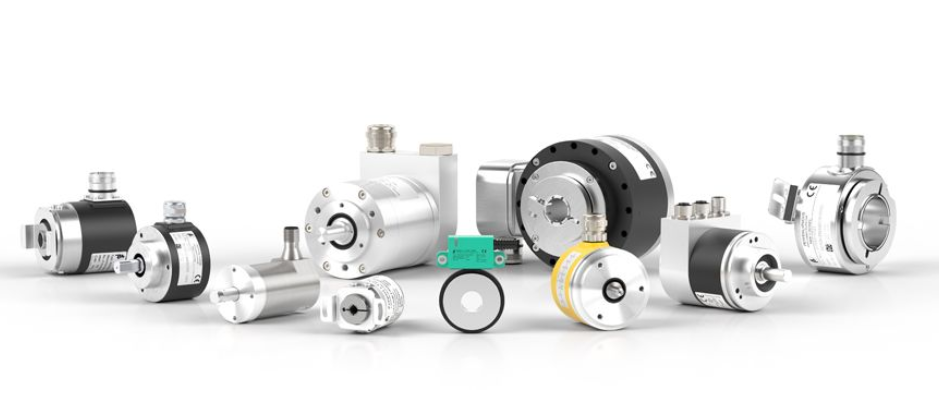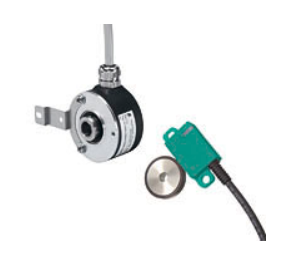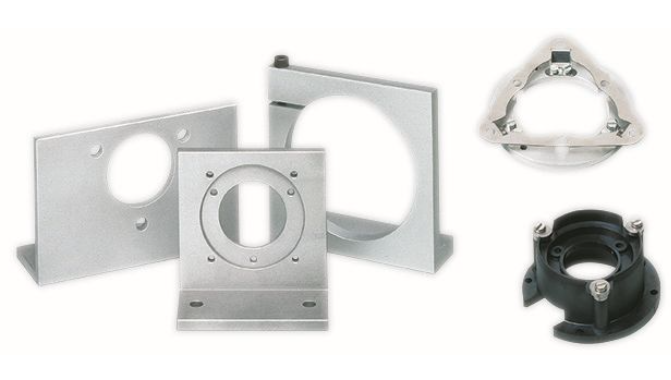Rotary encoders can be used in all applications that require monitoring rotation rate, speed, acceleration and direction. These sensors can be utilized in many applications found in mechanical engineering, the conveyor industry, material handling and the packaging industry. You are certain to find a suitable rotary encoder for your application from our broad product offering.
In automation, rotary encoders are used as sensors for angle, position, speed and acceleration. Linear motion can also be measured through the use of spindles, gear racks, measuring wheels or cable pulls.
Rotary encoders convert a mechanical input into electrical signals, which can be processed by counters, tachometers, programmable logic controllers and industrial PCs.
Absolute rotary encoders provide a distinctly coded numerical value for each shaft position. In positioning tasks in particular, the absolute encoders relieve the controller of computation tasks and keep costs down by eliminating the need for additional input components.
Moreover, reference runs when the machine is switched on or after power failures are no longer required as the current position value is available immediately. Parallel absolute encoders transmit the position value to the analyzing electronics through several parallel cables. Serial absolute encoders transmit their output data via standardized interfaces and protocols. In the past, point-to-point connections were frequently set up for serial data transmission but today fieldbus systems are being used more often.Interfaces:The Pepperl+Fuchs rotary encoder portfolio includes the most varied range of current interfaces for absolute encoders to be found on the market
:Parallel Interface
SSI-Interface
ASInterface
CAN
DeviceNet
Ethernet
PROFIBUS
PROFINET
Incremental rotary encoders supply a certain number of pulses for each shaft revolution. Speed is measured by counting the pulses for a period of time. To calculate angle or the distance covered, pulses are counted starting from a reference point.Dual channel quadrature output encoders feature two signal outputs that are 900 out of phase with each other. This permits the controller to determine direction of rotation and perform bi-directional positioning tasks. In addition, three-channel incremental encoders have a third signal channel (known as “zero”, or reference, signal) that provides a single pulse for each revolution
Rotary encoders for harzardous areas flame proof or intrinsically safe
Pepperl+Fuchs offers rotary encoders with two different ignition protection types. They are distinguished between the ignition protection type “flame proof enclosure” (EEx d) and the ignition protection type “Intrinsic Safety” (EEx i).Ignition protection type EEx d
Incremental encoders
Absolute encoders
Ignition protection type EEx i
In case of the ignition protection type EEx i the voltage and current levels are kept at such a low level that the occurrence of an ignition spark is prevented, thus preventing the ignition of an explosive atmosphere. The following devices are designed in accordance with this ignition protection type:
Incremental encoders
Cable pulls enable a rotary encoder to measure linear motion by providing a cable that is pulled in a straight line by the application.
Internally, cable is wrapped around a spring-loaded drum that turns the encoder's shaft when the cable is extended
Standard 58 mm diameter encoders mount to the adapter with synchro mounting elements
Cable pulls are an excellent tool for linear measurements with high resolution
The following rotary encoder accessories are available:
Mounting brackets
Couplings
Measuring wheels
Cable sockets
Cable pulls
Ashdale
We are an approved techncial partner for Pepperl + Fluchs products.
Our technical team are OEM trained and certified so you can trust us to provide the very best support for sales & service.
If you have an application, please get touch we love solving problems !














